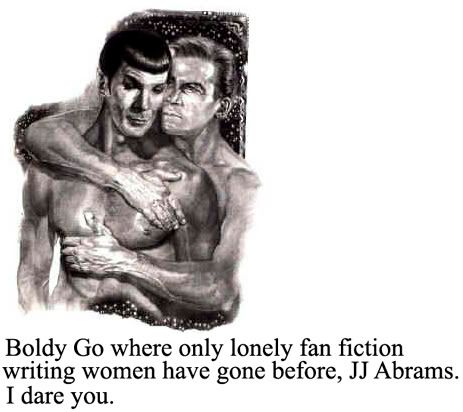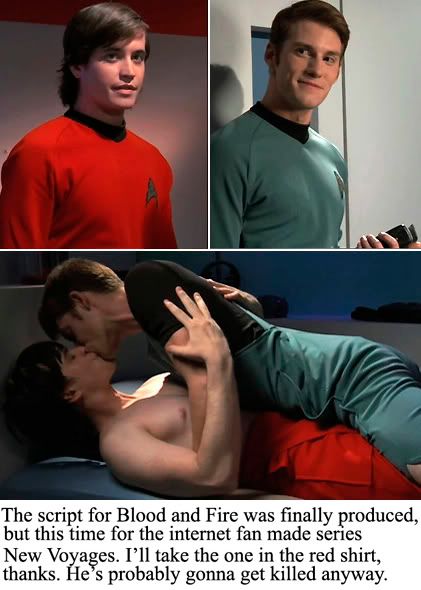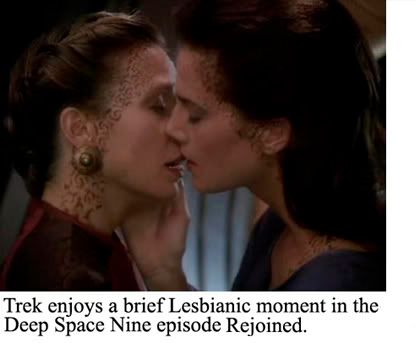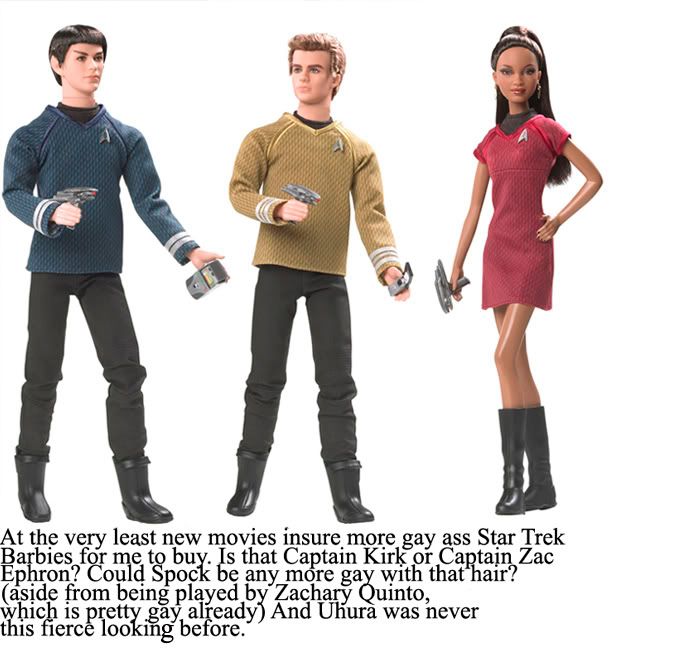It seems I’ve been a Star Trek fan all my life. Growing up with re-runs of the old show, not to mention being there as a kid for the theatrical runs of almost all of the original films, I’ve always been attracted to the idea of a multi-colored future where people of all races and creeds get along and can explore their paper-mâché galaxy together. Star Trek: The Next Generation premiered when I turned thirteen, and went off the air right as I turned twenty, so my formative years were spent with Captain Picard and the crew of the Enterprise D. So, needless to say, Star Trek is in my geek DNA. And whether I realized it as a kid or not, the notion of a future without prejudice or bigotry was very appealing to at least this one little queer kid.

It is well known today that the original series pioneered the concept of a gender and racially diverse cast. In 1966 It was very rare to see people of any ethnicity on television, or women in positions of authority, much less being officers on board a military vessel. Of course, the idea of having gay people on the original series was obviously never even brought up, as “gay” in 1967 still just meant “happy”. But in subsequent, more tolerant decades, the cry for Star Trek to include gays and lesbians in the 23rd and 24th Century idea of diversity seemed to fall on deaf ears. But it is something that has kept almost happening.
The Next Generation
When Star Trek: The Next Generation premiered in 1987, times were different than when the classic show aired. The gay activist movement, which had gained strength in the late 70’s, was now in full swing. But then again, so was the AIDS epidemic, and thus more intolerance and fear of gays than ever before. In the fall 1986, there was a massive Trek convention for the 20th anniversary convention of the original show. After a speech to a group of his faithful fans, Trek creator Gene Roddenberry took a question about the upcoming Next Generation show from a queer fan who was part of an LGBT fan group called “The Gaylaxians.” (*sigh* Yeah, the Gaylaxians. My peeps aren’t always clever folks) He asked whether there would be a gay character on the new show. He made the point that the classic show had been a leader in bringing minority characters to television, that this was the next logical step. And it seemed Roddenberry agreed. He said, “Sooner or later, we’ll have to address the issue. We should probably have a gay character.” Roddenberry mentioned “the gay issue” in a meeting with producers about the direction of the series. Some members of the staff were pretty shocked. TNG producer Robert Justman even made a remark about “ensign tutti-frutti”, according to writer David Gerrold, who wrote the classic episode “The Trouble With Tribbles” for the original series. According to Gerrold, “Gene very calmly explained that it was time.” But that time never really came.
Blood and Fire: The Gay Trek Episode That Never Was
But back in 1987, there almost was a gay character. A couple in fact. They were going to be minor crew members, sure. But it was something. David Gerrold was brought onboard to The Next Generation to write his first (and as it turns out, only) script for that series, which was called “Blood and Fire”. In the script, Captain Picard and the Enterprise answer a call from a distressed medical research vessel. The away team then finds that the ship’s crew is infected with “Regulan blood worms,” an incurable virus so deadly that Starfleet has ordered its officers to destroy any ship they contaminate. Aside from its obvious reference to AIDS paranoia, the script also contained a very slight reference to the homosexuality of two crew members. “How long have you been together?” Commander Riker asks a pair of male crewmen who accompany him to the infected ship. “Since the academy,” they say. It was just an offhand reference, but it was more than we had ever had before, and it showed to America that in the 24th Century, your sexual orientation is a non issue. In the future, they do ask and you do tell. And they apparently still let you serve.
After a series of arguments with Roddenberry’s underlings, Gerrold quit the show, and the episode was permanently shelved. Despite the fact that TNG was syndicated and didn’t have to answer to a network, the folks at Paramount were still nervous as hell about showing gay people in a positive light on any show which might be aired on Sunday afternoons (after church!) when kids could see it. Any sincere attempts to bring a LGBT character onto Star Trek were then met with serious resistance from the studio. “Blood and Fire” was eventually revived twenty years later, with some major revisions (and a lot more than just hand holding) on the internet fan made Trek series The New Voyages. In fact, it is really only in fan fiction, as well as some official under the radar tie-in novels, that there are any regular gay and lesbian characters in the Trek-verse.

In a 1991 interview with leading gay magazine The Advocate, Roddenberry promised that Season five of TNG would finally bring gay character to the series. Sadly, he died that year before that promise could be fulfilled. Instead of a regular new gay character, that season we got a thinly veiled gay rights episode called “The Outcast” about Commander Riker getting romantically involved with someone from a “gender neutral” species. (although she was very clearly female, much to the actor’s annoyance) It is a pretty good episode, although very heavy handed (but then so is most Trek really) After Roddenberry’s death in 1991, The Next Generation continued a run of what would be four Trek series that ran over 18 years. And not a single one of them had a gay or lesbian main character. Many fans blame Roddenberry’s heir Rick Berman, who ran the franchise (into the ground, most would say) from 1991 till 2005 when Enterprise was mercifully axed. Unlike Roddenberry, Berman was not that interested in Trek’s social agenda, merely it’s capacity to be a money making machine for Paramount. Under his watch, Trek avoided almost any controversy, while non genre shows like Ellen and Will & Grace (not to mention genre shows like Buffy)broke the barriers of queer characters on television. Breaking taboos and pushing the social envelope were no longer part of Trek’s agenda it seems. Star Trek was now as safe as Sesame Street.
Clearly doing the episode “The Outcast” was Rick Berman’s way of throwing the gay fans a bone, hoping it would silence their cries for a gay crew member. It didn’t. Berman then threw the gay fans yet another bone with the Deep Space Nine episode “Rejoined” in 1995. In that episode, regular cast member Jadzia Dax, herself a member of an alien species called the Trill who switch bodies and genders throughout the centuries, locks lips with her ex-wife from back when she was a man. This was another solid ep, but of course the gay implications of this story were never mentioned again on the series. Considering how hot the actress who played Dax (Terry Farrell) was, nixing any future same sex storylines was stupid on Berman’s part not only for pissing off the queer fanbase, but ignoring the rather large demographic of sex starved male Trek nerds who would have loved a little alien girl on girl smoochies.

JJ Abrams to the rescue?
Now Star Trek makes a triumphant return, albeit to the big screen and not the small one. The new Trek movie does not include any gay characters, since they are using the original series crew members who we already know to be hetero, (yeah, even Sulu smart ass). I still hope that maybe Abrams and other subsequent writers and directors for this new Trek-verse will have way more balls about including LGBT characters in future installments than the previous regimes in charge of Star Trek did. Maybe it won’t be revolutionary this time, but at least it will be fair. Now that Trek is back, the future is wide open. So I hope we get to hear some of those SWOOSH sounds on those Enterprise closet doors.
